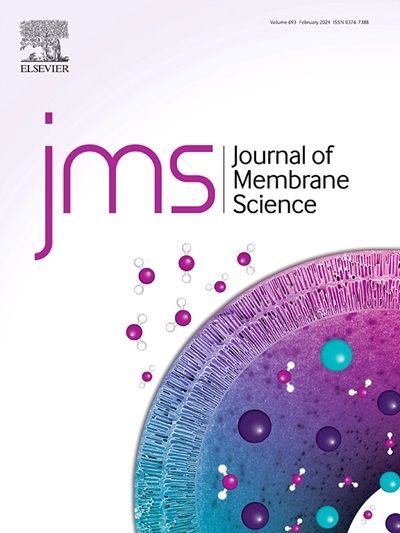Highly permeable anti-pollution separation membranes inspired by soil purification functions for efficient separation of dye/salt
IF 8.4
1区 工程技术
Q1 ENGINEERING, CHEMICAL
引用次数: 0
Abstract
The development of high-efficiency separation membranes is expected to realize the recycling of sustainable resources. It is important in separating dye/salt mixtures in textile wastewater, which can be separated by membrane separation technology to realize the reuse of dyes and salts. However, conventional membrane processes were generally constrained by the presence of fouling as well as energy and cost. The development of low-cost and high-performance separation membranes was particularly critical. Inspired by the fact that pollutants are absorbed and filtered by the soil, allowing the water to be purified. Low-cost and easily available montmorillonite (MMT) was selected and acid-modified to obtain AA-CMMT with large specific surface and pore structure. Preparation of polyimide (PI) membranes by blending AA-CMMT with membrane materials. AA-CMMT not only provides a water transport channel during separation, but also effectively reduces the attraction between the membrane surface and the contaminants. Improved membrane contamination resistance. Maintains high water permeability (above 110 L m−2 h−1·bar−1), dye retention (>98 %), and inorganic salt retention (<20 %) in long-term separation of dye/salt wastewater. This work provides a strategy for combining naturally low-priced soils with separation membranes, which has significant potential in wastewater treatment.

求助全文
约1分钟内获得全文
求助全文
来源期刊

Journal of Membrane Science
工程技术-高分子科学
CiteScore
17.10
自引率
17.90%
发文量
1031
审稿时长
2.5 months
期刊介绍:
The Journal of Membrane Science is a publication that focuses on membrane systems and is aimed at academic and industrial chemists, chemical engineers, materials scientists, and membranologists. It publishes original research and reviews on various aspects of membrane transport, membrane formation/structure, fouling, module/process design, and processes/applications. The journal primarily focuses on the structure, function, and performance of non-biological membranes but also includes papers that relate to biological membranes. The Journal of Membrane Science publishes Full Text Papers, State-of-the-Art Reviews, Letters to the Editor, and Perspectives.
 求助内容:
求助内容: 应助结果提醒方式:
应助结果提醒方式:


